
Search cheap and promo Korean Air flight tickets here!
Search and book cheap flights with Korean Air
Routes
Schedule
Price from
Korean Air's flight schedule
Airline | Departure Time | Arrival Time | Origin airport | Destination airport | |
|---|---|---|---|---|---|
Korean Air | 23:10 | 05:25 (+1 day) | Hanoi (HAN) | Seoul (ICN) | Book flight |
Korean Air | 23:30 | 06:55 (+1 day) | Bangkok (BKK) | Seoul (ICN) | Book flight |
Korean Air | 23:45 | 07:00 (+1 day) | Ho Chi Minh City (SGN) | Seoul (ICN) | Book flight |
Flight Deals from Australia ✈️
Airline Facilities

| Check-in Baggage |
|---|
| 20 kg |

| Cabin Baggage |
|---|
| 7 kg |
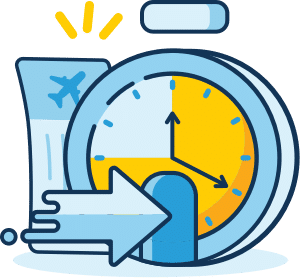
| Check-in Time Limit |
|---|
| 1 hour before departure |
Flight Services in Traveloka
Smart Combo
With Smart Combo tickets from Traveloka, you can book premium-service flights at up to 40% off. Enjoy flights with Air France, Cathay Pacific, Etihad, Garuda Indonesia, KLM, Lufthansa, and Singapore Airlines at a more affordable price. All you have to do is find the flights marked Smart Combo, then select the flight that suits your needs
Multi-city Flights
High Flexibility Ticket
Baggage
Seat Selection
In-flight Meal
Refund
Reschedule
Online Check-in
Price Alert
Flight Status
About Korean Air
Korean Air: An Introduction
If you dream of exploring vibrant cities, serene landscapes, or rich cultural experiences, Korean Air might be your ultimate travel partner. Known for exceptional service and a vast network of destinations, Korean Air offers an incredible gateway to Asia and beyond. Want to make your booking experience even better? Traveloka has you covered with exclusive promotions and seamless booking options, ensuring you snag the best deals on flights to the destinations of your dreams.
This post explores why Korean Air should be your go-to choice for your next adventure, where it can take you, and how Traveloka can make your planning easy while saving you money.
Why Choose Korean Air for Your Travels?
Korean Air is celebrated for its impeccable hospitality, comfortable seats, and extensive route network. But more than that, the airline offers a unique flying experience thanks to its exceptional attention to detail and commitment to passenger satisfaction.
Here are just a few standout benefits of flying Korean Air:
- Excellent Service: From friendly cabin crew to diverse in-flight entertainment, Korean Air prioritises your comfort and enjoyment.
- Award-Winning Cuisine: You can enjoy gourmet meals inspired by Korean culture or internationally inspired options to suit your taste.
- Extensive Route Network: With connections to over 120 destinations worldwide, Korean Air opens doors to cities across Asia, Europe, and the Americas.
No matter your travel goal—adventure, relaxation, or cultural immersion—Korean Air ensures that your trip starts in the best way possible.
Snap Up on the Best Korean Air Deals with Traveloka
Getting the most out of your travel budget is essential, and that's where Traveloka shines. Rather than looking for individual promos or deals, Traveloka simplifies the process by offering exclusive promotions that help trim your expenses.
During Traveloka’s seasonal sales like Black Friday, 12.12 Mega Sale, and the Traveloka Epic Sale, you can enjoy significant discounts on Korean Air flights, plus other perks for your trip. Using Traveloka to book your Korean Air tickets gives you access to exclusive, platform-only deals—making high-quality travel more affordable than you think.
And if you're booking last-minute? Traveloka makes it easy to find competitive pricing even with short notice.
Traveloka’s User-Friendly Features:
- Flexible Price Alerts: Set alerts to ensure you never miss Korean Air's best ticket prices.
- Seamless Payment Options: Choose from multiple secure payment methods, such as credit cards, or bank transfers for hassle-free installments.
- Bundle Deals: Mix and match flights with hotel accommodations at discounted rates, all in one place.
Using Traveloka is not just budget-friendly; it’s also a faster and more reliable way to enjoy booking without endless searching or comparison.
Where Does Korean Air Fly to?
One of the most significant advantages of flying with Korean Air is its various destinations, which cover major global hubs and hidden gems. Here's a glimpse of where Korean Air can take you—with Traveloka as your booking partner.
Explore the Heart of Asia
Korean Air connects you directly to South Korea, with Seoul as its central hub. Curious about what awaits? Enjoy vibrant K-pop culture, shop in Myeongdong, or rejuvenate with serene temple stays. You can connect seamlessly from Seoul to destinations like Tokyo, Bangkok, or Taipei.
Discover Europe’s Cultural Treasures
Dreaming of Parisian landmarks, Italian cuisine, or castles in Germany? Korean Air offers flights to major European cities like Paris, Madrid, Rome, and Frankfurt.
Visit Under-the-Radar Locations
Korean Air also flies to less-crowded destinations, such as Ulaanbaatar in Mongolia, Vladivostok in Russia, and Chiang Mai in Thailand. Each location offers unique opportunities for cultural interactions and spectacular scenery.
Journey into the Americas
With direct flights to cities like Los Angeles, New York, Vancouver, and São Paulo, Korean Air ensures comfort during long-haul travel while giving you worldwide access.
Booking your Korean Air flights through Traveloka ensures you'll have peace of mind no matter where your ticket takes you.
Find Last-Minute Deals on Korean Air with Traveloka
Sometimes, the best trips are spontaneous. Korean Air is known for its extensive availability, even if you book at the last minute. Through Traveloka, finding a great fare becomes more straightforward and quicker, aligning your willingness to explore with offers that work for your wallet.
What makes it even better? Traveloka’s seasonal discounts and flash sales on last-minute bookings. With their convenient app and price transparency, you won’t need to stress over travel logistics—just pick the destination, book your ticket, and pack your bags.
Make Travel Effortless with Traveloka
Travelling is about soaking in the experiences, not worrying about the nitty-gritty details. Traveloka brings simplicity to your trip planning. With promo alerts, seamless booking, flexible schedules, and access to a range of deals, Traveloka helps you save time and effort every time you book.
Whether planning an elaborate vacation or a quick weekend escape, Korean Air and Traveloka are your ultimate duo for creating hassle-free, memorable journeys.
Korean Air Seat Class
Economy Class
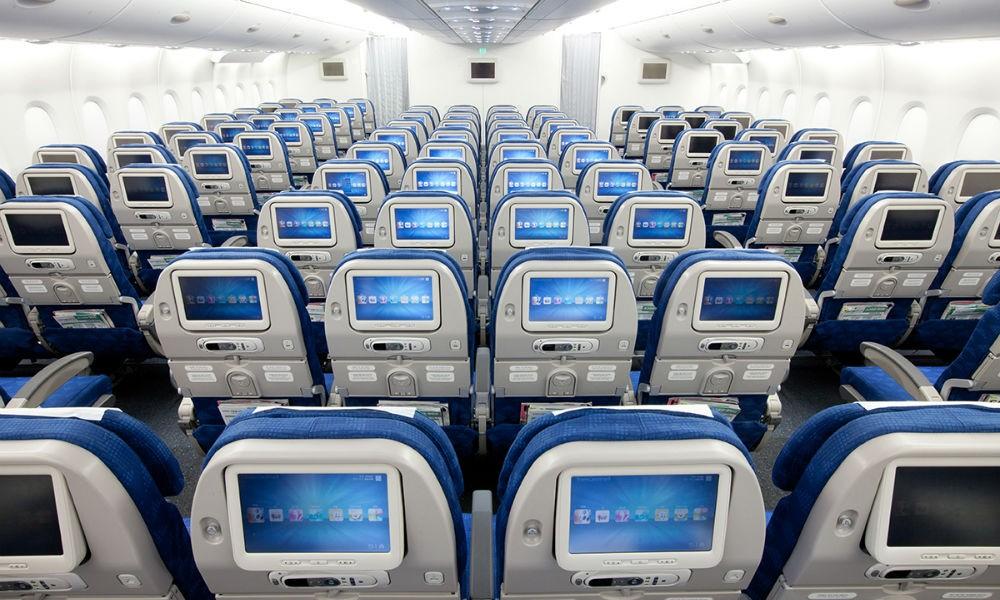
Korean Air provides the ultimate comfort in its most affordable flight class. The cabin offers reclining chairs with 34-inch legroom and 18-inch width for maximum comfort. The chair can be reclined to an 118-degree angle for better comfort. Each seat is equipped with an LCD screen that features various music playlists, Videos on Demand, short movies, and many more. Passengers can choose their seats from 361 days to 48 hours before departure.
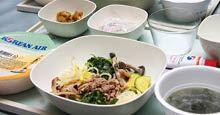
In-flight Meal
Korean Air offers diverse selections of Korean, Japanese, and Chinese dishes, depending on the flight route. Passengers can enjoy authentic Korean dishes such as bibim noodles, Gondreabap, bibimbap, stir-fried octopus, rice, and vegetables. Passengers on a long-haul flight can also enjoy snacks such as rice cakes, samgak kimbap, pizza, and cup ramen.
Prestige Class

Korean Air offers an improved and luxurious service in its business class, otherwise known as the Prestige Class. Seats in the Prestige Class are 21-inch wide and provide more spacious legroom compared to the Economy Class, completed with a footrest. However, each seat is equipped with the same entertainment facilities as Economy Class. Korean Air also offers Prestige Plus, Prestige Sleeper, and Prestige Suites seats for extra sleeping space and privacy.

In-flight Meal
Korean Air serves various Korean dishes such as Dongchimi noodles, bibimbap, bulgogi, soy-sauce marinated crab, and galbi-jjim. All dishes are served on a simple, yet stylish dishware. Passengers in Prestige Class can also taste high-quality wine from Italy, Germany, California, and France, including the famous Perrier-Jouet.
First Class

Korean Air’s First Class offers selections of spacious, private seats with various amenities. Passengers can choose between Kosmo, Kosmo Suites, Kosmo Sleeper, and Sleeper, which provides ample space for sleep and work. Individual reading lights, adjustable sleeping-seats, and partitions create a comfortable space for long-haul flights. Passengers also get to enjoy a personal LCD screen for entertainment, along with headphones and on-demand videos.
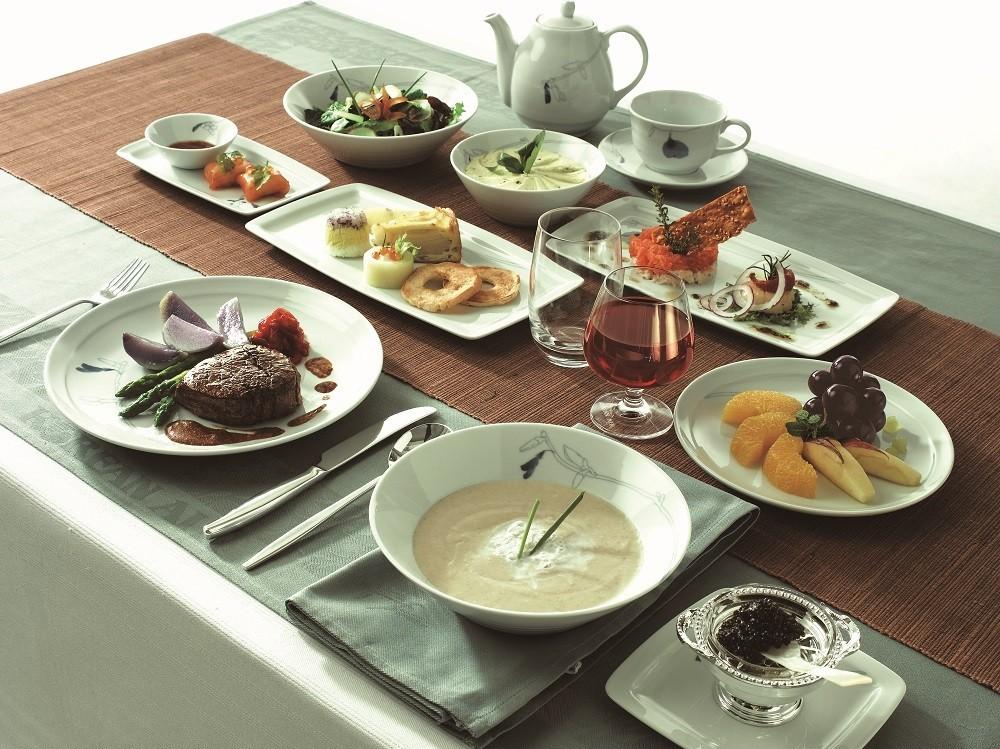
In-flight Meal
Meals served in First Class uses only the freshest ingredients from Jeju Island, served on elegant dishware. Passengers can enjoy traditional Korean dishes such as bulgogi, kimchi, Dongchimi noodles, bibimbap, and soy-sauce marinated crab. Passengers can also choose between selections of gourmet wine, from Alsace, Bordeaux, or Bourgogne.
Korean Air Privilege Programs
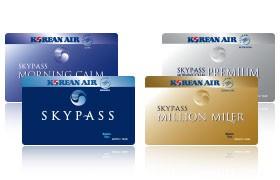
SKYPASS
Korean Air offers SKYPASS, a frequent flyer program that gives benefits for any Korean Air passenger age 12 years and above. Members can earn points, benefits, and rewards every time they fly with Korean Air or use other services affiliated with the airline. SKYPASS offers three tiers of benefits from Morning Calm, Morning Calm Premium, and Million Miler Club. Benefits include exclusive check-in, additional baggage allowance, access to KAL lounge, discounts, and many more. Passengers under 12 years old can also enjoy various benefits from the SKYPASS Junior program.
Korean Air Fleet
Airbus 380-800
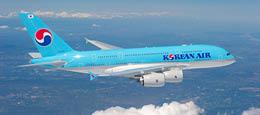
- Economy
- Prestige Class
- First Class
Available
- 3-4-3 (Economy)
- 2-2-2 (Prestige Class)
- 1-2-1 (First Class)
Not Available
- 34 inches (Economy)
- 74 inches (Prestige Class)
- 83 inches (First Class)
Available
Boeing 777-300ER
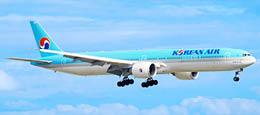
- Economy
- Prestige Class
- First Class
Available
- 3-3-3 (Economy)
- 2-3-2 (Prestige Class)
- 1-2-1 (First Class)
Not Available
- 33 inches (Economy)
- 74 inches (Prestige Class)
- 83 inches (First Class)
Available
Korean Air In-flight Crew
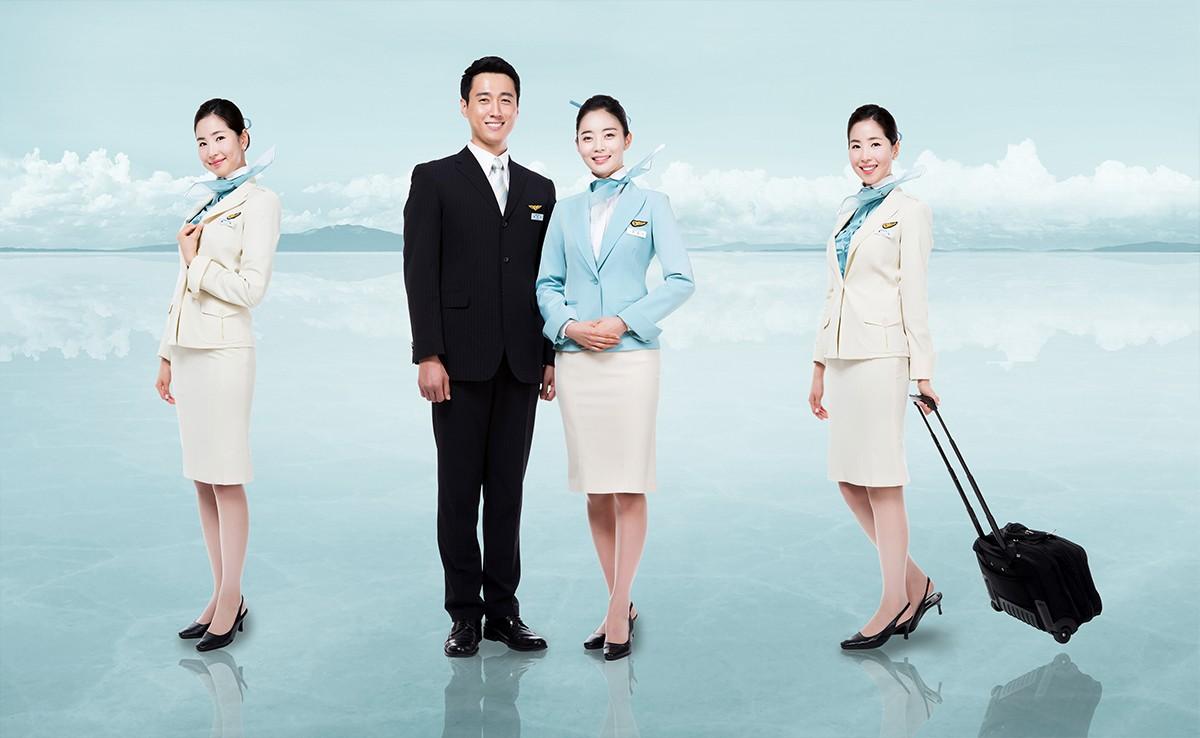
Korean Air Flight Attendant Uniform
Korean Air flight attendant wears a combination of a sky-blue suit with a white shirt underneath and a white knee-length skirt. An elegant blue-and-white scarf complements the whole piece, creating a simple but refined look. The uniform was designed by an Italian designer, Gianfranco Ferré, and is made with ergonomic and comfortable materials. The design and color scheme were chosen to reflect Korea’s classic beauty, while still reflecting international, modern fashion sense. The comfortable material and design help the staff to assist passengers more quickly and effectively.
Korean Air Baggage Allowance
Flight Route | Seat Class | Cabin Baggage | Checked Baggage |
Domestic | Economy Class | Max. 12 kg (Dimension: 55 x 20 x 40 cm) | Max. 20 kg (Dimension: max. 158 cm) |
Prestige Class | Max. 18 kg (Dimension: 55 x 20 x 40 cm) | Max. 30 kg (Dimension: max. 158 cm) | |
International | Economy Class | Max. 12 kg (Dimension: 55 x 20 x 40 cm) | Max. 23 kg (Dimension: max. 158 cm) |
Prestige Class | Max. 18 kg (Dimension: 55 x 20 x 40 cm) | 2 pcs (max. 32 kg/pc) (Dimension: max. 158 cm) | |
First Class | 3 pcs (max. 32 kg/pc) (Dimension: max. 158 cm) | ||
All flights to America | Economy Class | Max. 12 kg (Dimension: 55 x 20 x 40 cm) | 2 pcs (max. 23 kg/pc) (Dimension: max. 158 cm) |
Prestige Class | Max. 18 kg (Dimension: 55 x 20 x 40 cm) | 2 pcs (max. 32 kg/pc) (Dimension: max. 158 cm) | |
First Class | 3 pcs (max. 32 kg/pc) (Dimension: max. 158 cm) |
Korean Air Passenger Policy
Infant Passenger Policy (0-2 Years Old)
- Infants younger than 7 days are not allowed onboard.
- Infants can fly free of charge on domestic flights but will be charged 10% of the adult fare for international flights.
- Infant passengers will not be assigned an individual seat unless passengers purchase a child ticket.
- Korean Air only allows one infant passenger per adult.
- Infant passengers flying on a domestic flight are allowed to bring one car seat or baby bassinet, and one foldable stroller. While on international flights, infant passengers are allowed to bring one car seat or baby bassinet, one foldable stroller, and one item under 10 kg and no larger than 115 cm in width, height, and length.
- Korean Air serves orange juice and formula for infants under 12 months. Infants between 12–24 months will be served baby food.
- To order an infant meal, passengers are required to contact the airline at least 24 hours before departure. However, Korean Air does not accommodate meals for infants with allergy.
- Baby bassinets are available in several international flights. Passengers are required to contact the airline at least 48 hours before departure to use the baby bassinet.
- Baby seats are available for infant passengers, while baby harnesses are available for all passengers under five years old. Passengers are required to contact the airline at least 72 hours before departure to use these services.
Child Passenger Policy (2-12 Years Old)
- Passengers must be at least five years old to be able to travel alone. Unaccompanied Minor service is also available if the person accompanying the child is under 18 years old, or if they do not travel in the same plane cabin.
- Unaccompanied Minor service is subject to standard child fare for domestic flights, and standard adult fare in international flights.
- Unaccompanied Minor service is also available for passengers aged 12 to 16 years old. However, standard adult fare applies for this service.
- Parents or guardians must apply for Unaccompanied Minor service at least 24 hours before departure time. The airline will discuss the child's identity, contact information, and pick-up details.
- Korean Air requires the Unaccompanied Minor to be picked up as per discussed. Otherwise, he or she will be returned to the departure point, at the expense of the minor’s parent or guardian.
Pregnant Passenger Policy
- Korean Air provides a complimentary kit for pregnant passengers. Passengers are required to inform the airline at least 24 hours before departure time to arrange services.
- Passengers with single or multiple pregnancies of less than 32 weeks are allowed to fly without any requirements.
- Passengers with a pregnancy between 32 and 36 weeks must inform the airline about the pregnancy term during booking, and submit a special Declaration Page that can be downloaded at the Korean Air official website.
- Passengers with a single pregnancy of 37 weeks and above, or multiple pregnancies (pregnant with two babies or more) of 33 weeks and above, are not allowed to fly for safety reasons.
- Pregnant passengers with complications or specific conditions must submit both the Declaration Page and a medical certificate. The medical certificate must be filled and signed by the passenger’s regular OB/GYN doctor.
Disabled Passenger Policy
- Korean Air provides a wheelchair service with an escort. Passengers who need to use this service are required to inform the airline during booking.
- Korean Air applies the first-come-first-serve rule for the wheelchair service. Wheelchairs will be given to passengers with prior reservation.
- The wheelchair service is available to transport passengers from the check-in counter to the plane and from the plane to the arrival area. A professional escort will help to accompany the passenger during the transfer.
- The wheelchair and escort service are not available for passenger’s personal errands, such as shopping, and are not available outside the terminal.
- Passengers can bring their own wheelchairs, as long as it complies to the regulation related to the plane's dimension. A small plane such as B737 does not accept wheelchairs larger than 112 x 84 cm.
- If the wheelchair is battery-powered, passengers are required to inform the airline during booking. The battery must be stored safely, and the battery terminal must be insulated to prevent fire hazards.
- Passengers who bring their own wheelchairs can still ask for help from the airport staff and cabin crew to move around.
- Passengers with further inquiries regarding wheelchair type, requirements, or physical conditions can contact the airline during booking.
Korean Air Check-in Policy
Korean Air Check-in Time
Please find the check-in time for all Korean Air flights on the table below. Check-in time may vary if your flight is operated by a partner airline. Please check your e-ticket to ensure.
Flight Route | Recommended Check-in Time | Check-in Time Limit |
Domestic | 1 hour before departure | 20 minutes before departure |
International | 1 hour 30 minutes before departure | 40 minutes before departure |
All flights to North America | 2 hours before departure | 1 hour before departure |
Korean Air Online Check-in
Online check-in is also available for Korean Air flights. Please follow the steps below.
- Go to Korean Air web check-in page
- Enter your booking code, or other booking details, as instructed
- Complete your check-in details
- Save and/or print your boarding pass
Korean Air Refund Policy
In general, refunds are permitted for personal reasons (self-cancellation, sickness, pregnancy, or death of a passenger), cancellation/rescheduling by the airline, force majeure, or double booking. However, different airlines have different policies regarding acceptable refund reasons. Please visit Korean Air Refund Policy for a complete information on refund.
Korean Air Reschedule Policy
You can easily change your flight schedule and itinerary using Easy Reschedule. Some airlines allow changes to date, time, route, and airline, while some only allow changes to date and time.
Please refer to Korean Air Reschedule Terms & Conditions to find the complete guide to rescheduling your flight. If your flight is not eligible for Easy Reschedule, please contact Korean Air directly to reschedule.
About Korean Air
Korean Air (IATA Code: KE) is the main and largest flag carrier in South Korea, and also one of the founding members of SkyTeam, the largest airline alliance in the world. Considered as one of the top 20 airlines in the world, the airline currently serves both domestic and international flights to 131 destinations across 46 countries. Korean Air has two main hubs, which are the Incheon International Airport and Gimpo International Airport, as well as two secondary hubs, which are Gimhae International Airport and Jeju National Airport. Across the years, Korean Air has gained several achievements. The airline was named as Asia’s Leading Airline for its First Class service in 2010, 2011, 2012, 2013, and 2014. It was also named as World’s Most Innovative Airline in 2011, 2012, and 2013. Korean Air was also awarded the World’s Excellence in Service Award in 2012 for its overall service quality. Korean Air offers a frequent flyer program called SKYPASS, which is available for passengers age 12 years old and above. Members can enjoy various benefits and rewards such as discounts, upgrades, access to Korean Air lounge, check-in priority, and many other privileges. To earn the membership status, passengers need to fly at least 30,000 miles every two years. Passengers can also earn points by using services affiliated with Korean Air, such as car rentals and hotels. SKYPASS Junior is available for passengers younger than 12 years old. Passengers can choose to fly in three different flight classes, which are Economy Class, Prestige Class, and First Class. Each class offers comfortable seats, high-quality entertainment such as LCD-screen, video on demands, and music playlists. First Class also provides several types of seats to choose from, offering privacy, personalized entertainment, and ample space for relaxing or working. The newest option for First Class seat, the Kosmo Suites 2.0, provides tall partitions and sliding door, plus a working table for more privacy and freedom. Economy Class passengers are entitled to 23 kg of checked baggage, while Prestige Class and First Class passengers are entitled to 32 kg of checked baggage. All checked baggage must not exceed 158 cm in height, weight, and depth. Moreover, Economy Class passengers are also allowed 12 kg of cabin baggage, while Prestige Class and First Class passengers are allowed 18 kg of cabin baggage. SKYPASS members also get an additional free baggage allowance of 23 kg for Economy Class and 32 kg for Prestige Class and First Class. Korean Air passengers are required to check in at least 20 minutes before departure for domestic flights, and 40 minutes before departure for international flights. However, airports in Europe, Middle East, and the United States limit their check-in time to 60 minutes before departure due to security reasons. Boarding time for domestic flights is limited to five minutes before departure, and 10 minutes for international flights. Korean Air strongly urged passengers to arrive earlier at the airport to ensure enough time for check-in and boarding. Korean Air KE627 connects Jakarta (CGK) via Soekarno–Hatta International Airport to Seoul (ICN) at Incheon International Airport. Operated by a Boeing 777-300ER, this flight offers three service classes: Economy, Business, and First Class. With an age of approximately 12 years and 11 months, Korean Air KE627 accommodates up to 291 passengers. It is advisable to regularly check the flight status for the latest information regarding departures and arrivals.
Korean Air History
Korean Air, formerly known as Korean Air Lines, was established by the South Korean government in 1946 to replace the declining Korean National Airlines. Hanjin Transport Group, a private company, later acquired the airline on 1 March 1969, changing the airline's status from state-owned to private. The privatization process encouraged the airline's development to become a respectable company, steadily growing into a large-scale carrier service and passenger airline. In April 1971, Korean Air started its first international freight service to the United States, with Seoul – Tokyo – Los Angeles route. One year later, Korean Air started its international flight to the same country, with Seoul – Tokyo – Honolulu – Los Angeles route. Korean Air later added Boeing 747 to its fleet and started to operate its European routes, with the first flights flying to Paris in 1973 (cargo) and 1975 (direct passenger flight). Korean Air also started its first passenger service to the United States in March 1979, with its first direct flight from Seoul to New York. Korean Air saw the beginning of a full revitalization in the 1980s. First, the airline got a new, dedicated cargo terminal in Los Angeles. The airline also introduced a new system called Total Passenger Service System (TOPAS), which was an integrated reservation and ticketing system. Then, the airline opened its own Flight Crew Training Center in January 1984. The company name was also changed in March 1984, from Korean Air Lines to Korean Air. Finally, a new logo that featured the familiar red-and-blue Taegeuk (Korean Yin-Yang circle) was introduced. The logo was established to represent the company’s continuous growth and innovation. Korean Air then added new international routes during the 1990s. In April 1990, the airline opened its first Australian route with a Seoul – Sydney flight. In October 1992, the airline flew its first passenger flight to Sao Paulo, Brazil. In December 1994, the company added several routes to China, such as to Tianjin, Qingdao, Beijing, and Shenyang—all of which were direct flights from Seoul. Korean Air also started its first Computer Center in October 1990 and saw the first graduates of pilots from Korean Air Pilot Training Center in May 1992. Korean Air finally introduced its 100th aircraft in 1995, a Boeing 747-400, showing a promise of future growth in welcoming the 21st century. However, the market for airline service in South Korea had been overly-saturated back then, with many of the competitions offering cheap costs as the main appeal. Therefore, Korean Air started to broaden its venture to another travel establishment by opening Cheju KAL Hotel in May 1996. The airline also added new A330-300 and B777-200 aircrafts to its fleet in 1997. In 1998, the company achieved a historical milestone when one of its cargo planes finally flew over North Korea, after being banned for years in the years before. Korean Air also started its widespread global alliance in 2000 by partnering with Delta Airlines, Air France, and Aeroméxico through SkyTeam. It also added a new crew training center in Gimpo, to accommodate its growing services. Yang Ho Co, the son of Korean Air founder Choong Hon Co, became the new CEO in 1999 and brought several innovations and business plans to face the upcoming growth and competition. Korean Air then revitalized its corporate identity in the mid-2000s. In 2004, on the airline’s 35th anniversary, Korean Air adopted a new logo. The new logo features a modification of the Yin-Yang symbol, with red and blue colors, split in the middle with a white propeller. The logo was created to established Korean Air’s status as the flag carrier of South Korea, while also symbolizing the balancing force of company dynamics. In 2005, Korean Air was internationally known as the Number One Cargo Carrier in the world. The airline also started to publish its own in-flight magazine, titled Beyond, in 2006. In 2007, Korean Air launched a low-cost air carrier service called Jin Air, which was designed to compete with Korea Train Express (KTX), a high-speed railway system. The airline also started its first flight to Japan with Seoul – Narita route in 2011, using the Airbus A380 aircraft. Korean Air also refurbished many aspects of its technology in the 21st century. For example, the company completed its ERP system and opened HJ Navoi Complex in 2012. The airline also added a new aircraft to its fleet, a Boeing 747-8, which was the first of intercontinental aircraft of its kind. It also perfected its Passenger Service System in 2014, and finally opened an engine test facility together with P&W in 2016. Now, Korean Air is recognized not only as the largest South Korean airline, but also one of the best airlines in the world in terms of service and technology.
Korean Air Destinations
Korean Air Popular Routes
Korean Air Booking & E-ticket
How to Book
Here’s how you can book your Korean Air ticket online:
- Go to Traveloka website or open your Traveloka App
- Fill in the flight details in the search box
- Choose and book your flight
- Fill in contact information and passenger details
- Complete your payment through the selected method
- Receive your Korean Air e-ticket in My Booking or in your email
How to Pay
Payment for your Korean Air ticket can be made via bank transfer (ATM/SMS Banking/e-banking/bank teller), credit card, and Indomaret.
For complete information about payment methods, please visit How to Pay.
Korean Air E-ticket
Korean Air e-ticket is an eligible proof for booking an Korean Air flight. Show your e-ticket during check-in at the Korean Air counter at the airport, or use it for self check-in (at the airport or online), to get your boarding pass. If you have not received your e-ticket within 60 minutes after payment is completed, please contact Traveloka Customer Service.
Contact Korean Air
Korean Air Office
Korean Air
Mayapada Tower 9th Fl.
Jl. Jend. Sudirman Kav. 28
Jakarta 12910
Contact Korean Air
(021) 521-2180
Popular Hotels
Popular Flight + Hotel Packages







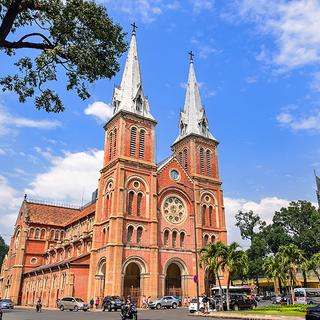




















































 Instagram
Instagram TikTok
TikTok Youtube
Youtube
